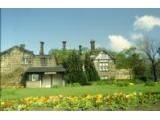Abbey House Museum - Leeds
| |||||||||||||||||||||||
William the Conqueror gave the Kirkstall area to one of his Norman followers, Ilbert de Lacy in the 11th century. A descendent of Ilbert, Henry de Lacy, made a grant of land to the Cistercian monks who started building Kirkstall Abbey in 1152. The monks built a gatehouse to the north west of the Abbey, which is the oldest part of Abbey House and now houses the café. In 1539 the Abbey was taken over by Henry VIII. The monks were forced to leave and the Abbey fell into ruin. The last abbot, John Ripley, made the gatehouse, Abbey House, his home until his death in 1568. A home From then on, Abbey House became a residence, first for farmers, then for notable Leeds families such as the Butlers of Kirkstall Forge. In 1888 Colonel North bought the Abbey and presented it to the people of Leeds. He sold Abbey House to Colonel Harding in 1893 and the latter was responsible for the neo-gothic decoration still to be seen in the De Lacy room and the oak staircase. A museum Colonel Harding retired to Cambridge and more members of the Butler family lived at Abbey House until 1925 when the house was sold to Leeds Corporation. Abbey House opened to the public as a museum in 1927. During the 1950s Victorian street scenes were added. In 1995, the centenary of the reopening of Kirkstall Abbey by the city, it was decided to raise the money needed to redisplay and improve facilities for visitors. The Heritage Lottery Fund, Leeds City Council and the Friends of Leeds Museums made this work possible and work was completed in 2001. | |||||||||||||||||||||||
